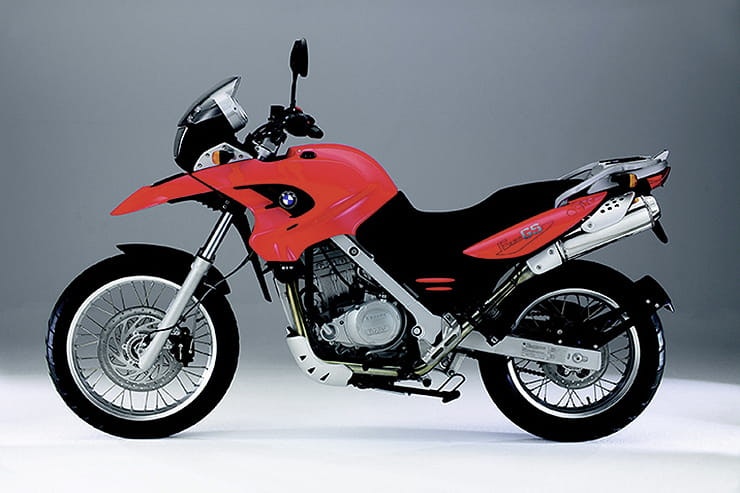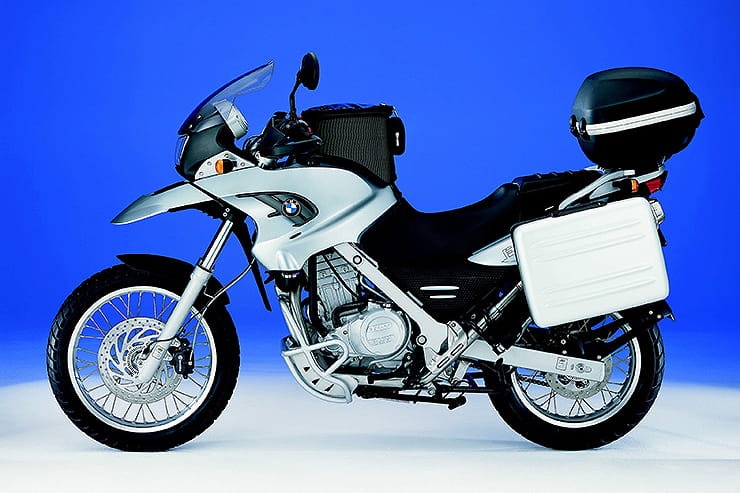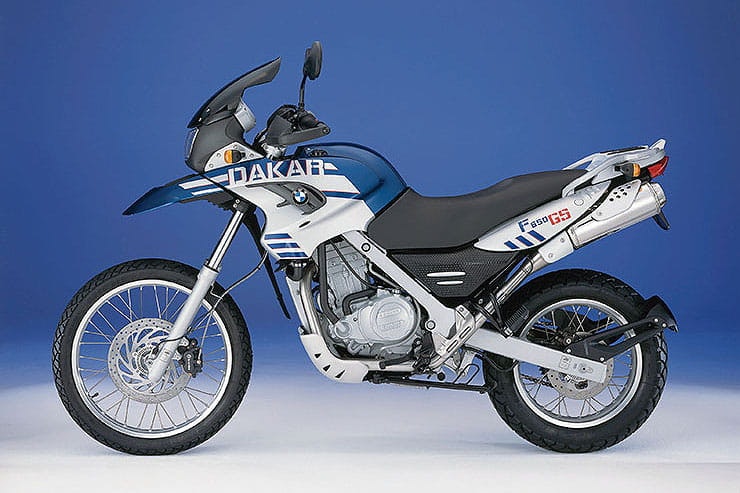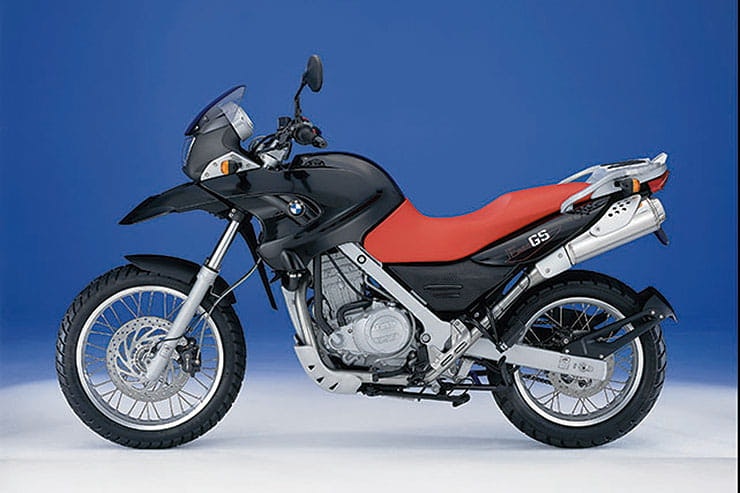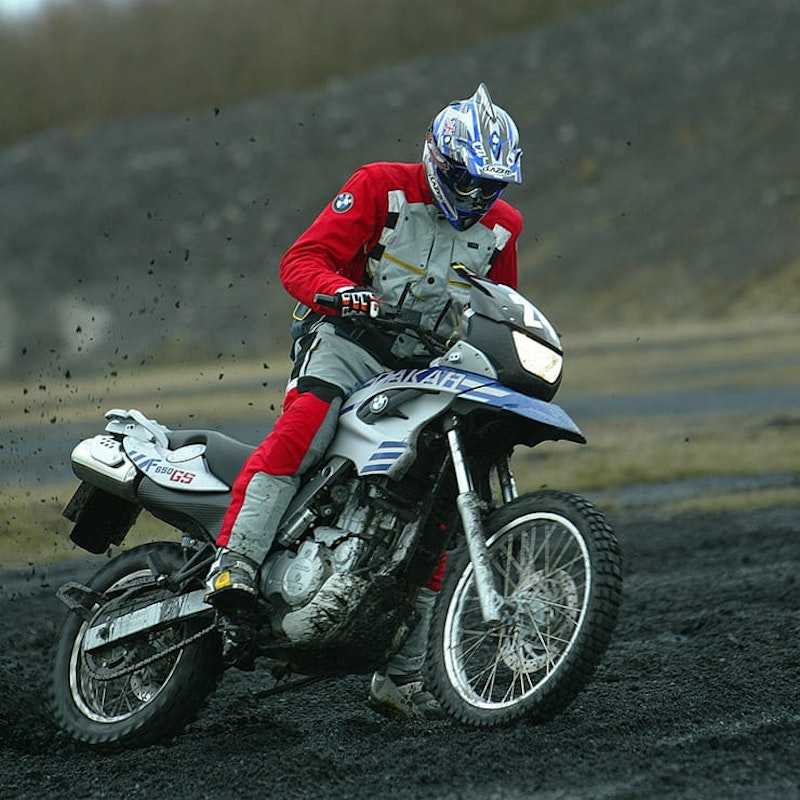BMW F650GS and F650GS Dakar (2000-2007) - Review & Buying Guide
By Jon Urry
Massively experienced road tester
11.10.2022
There is nothing wrong with no-frills motoring and if you are after a very cheap and solid commuter that is more than up for a bit of green lane action at the weekend, BMW’s F650GS models are well worth considering. But what are they? When you hear F650GS you may think it is the parallel twin engine, however that’s not in this case. True, BMW’s parallel twin (launched in 2008) was (confusingly...) also called the F650GS in its more road-focused guise despite its 798cc capacity, but we are talking about the first F650GS here and it carries a single cylinder motor with a 652cc capacity.
Initially unveiled in 1993 as the F650 Funduro, and powered by a Rotax-designed engine built by Aprilia, the F650 grew in stature in 2000 and became the F650GS thanks to a thoroughly refreshed motor and chassis. Running from this point until 2007 when the F650GS (yes, yes, we know...) replaced it as well as the (fairly forgettable...) G650 models a little while later, the single cylinder GS is one of those bikes that is basic but does what it does very well and as such has built up quite a worldwide fan base. It won’t set your world on fire, but it will do all that is asked of it and makes for a great winter hack that can easily be service at home, saving you even more cash.
BMW F650GS and F650GS Dakar (2000-2007) Price
The F650GS was always designed to be a wallet-friendly machine and when new it cost just £4999 for the stock model or £5599 for the slightly flashier Dakar with its more off-road focus and bigger front wheel. Now that it has been superseded by the parallel twin models, the single cylinder has fallen a bit out of favour and is basically viewed as a solid commuter or a cheap hack. Due to this status, not to mention its age, nearly all F650GS models are sold privately and while a few dealers have them advertised, this isn’t the best place to locate them as to make them worth their while to have on a showroom floor, a dealer needs to ask a high price tag. If you want a very tidy example and are willing to pay up to £2500 or even £3000, this is an option, but you are much better off going private through an online auction or sales page instead. Hit eBay (or similar sites) and you can locate F650GS models for as low as £800 but you get what you pay for and have to expect it will be a tatty high-mileage bike with (hopefully!) a long MOT and not too many bent bits. Aim to spend roughly £1500 for a better example from a private owner who has cared for it instead. The Dakar model may add a few quid to the price tag but in general used values are the same due to age/condition etc.
Power and torque
With just 50bhp and 44ftlb of torque, the F650’s single cylinder motor isn’t the most powerful and performance certainly isn’t one of its strongest points. Unlike a modern single such as the KTM 690, which has a remarkable turn of pace and fast-revving attitude, the BMW’s unit is far more targeted at plodding along and reliability. A fairly low red-line of just over 8000rpm means that there is no requirement to go searching out power through revs but by the same token there isn’t much there to discover either. It’s a motor that feels exactly what it is –old and dated but happy to just thump along and get on with its task at a sedate pace. And a fair few vibrations...
Engine, gearbox and exhaust
When it comes to the motor, there was only one update of any significance over the F650GS’s lifespan, which happened in 2004. A new twin spark engine and refined engine management system was claimed to improve fuel economy and also lower the peak torque point but, in all honesty, you won’t spot the upgrade when you are riding it. A very robust engine, seeing GSs with over 40,000 miles on their clocks isn’t unheard of at all and that’s great news for a used buyer. However, there are a few things to be wary of. The water pump is driven by plastic gears, which can become brittle and snap with age. Replacements are only about £50 so it’s not a huge drama and as the pump’s seal also likes to fail, it is worth updating these two items as a precaution. Keep an eye on the temperature gauge when the bike is ticking over and if it starts to creep up, assume the pump needs a bit of TLC. And while you are there, check the state of the radiator, which can corrode and leak, as well as if the fan is kicking in or not as they can also fail. The GS only has a five-speed gearbox, so don’t go looking for a sixth, but do check the casing around the front drive sprocket as the nut is known to work loose and this can lead to damage. Again, as a preventative measure, check it is nice and tight and maybe add a dab of thread lock just to be safe or search out the updated deeper threaded nut which later models had. You are highly unlikely to find a bike with much of a service history, machines that are under £2000 tend to lack this, but the valve clearances should be checked at 6000-mile intervals and this is quite important so see if it has been done recently. It will cost about £250 to get done by a competent non-BMW mechanic, possibly more if any shims are required. You can buy a full GS service kit (oil, filters, plugs) for about £70 and a basic service should be well within any semi-competent mechanic’s skill set – although stripped sumps plug threads are common, so look at the plug to see if there are any tell-tale signs of a rounded end, chemical metal or sealant!!! Some older bike may be starting to suffer from perished fuel lines by now, so always smell the bike for any hint of a fuel leak.
BMW F650GS and F650GS Dakar (2000-2007) Economy
BMW claimed the new BMS-C II engine management system, which was introduced alongside the twin spark head, boosted the GS’s economy by 6% at 56mph to 88mpg and 14% at 75mph to 65.7mpg. In reality owners tend to average closer to 65mpg over a variety of riding conditions on both generations, which is pretty respectable and sees the 17.3 litre tank good for over 250 miles between fill-ups.
Handling, suspension, chassis and weight
The F650GS wasn’t built as a sporty bike (although it does have a slightly sportier cousin, the F650CS, which is very ugly but has 17-inch wheels and a handy space in its tank area for luggage) and it handles like a old-fashioned enduro. You can ride it merrily but try to get too excited and it all goes a bit wobbly as the suspension is quite poor. The stock GS has a 19-inch front wheel, which makes it better handling than the 21-inch fronted Dakar, and also lowers its seat height. Those shorter in the leg may well find the 870mm seat height on the Dakar too much of a stretch where the 780mm GS is far more accessible. As you would expect on a bike with spoke wheels, checking the condition of the rims and spokes is a must as they rust and bend, and also see how its bearings are holding up as they can wear out fast. A lot of owners say that older models can develop wiring loom issues, which isn’t unexpected, so always check the electrical system and be wary of a bike that has a dodgy battery as that could mean the reg/rec is on its way out and is cooking the battery. A new one is only about £80 but the worry is how many wires it may have overheated before you swapped it! Again, no fault of the GS as such but always check the forks for damage, bends or leaks from the seals and the shock linkages for damage and that the shock has some life in it. There is a fair chance the preload adjuster will be seized solid, most are, so see if has any movement in it. Remember, this is a pretty old bike that is favoured as a hack and can be picked up for less than £1000 so you need to assume it has been crashed at some point. As long as the spill was slow speed that’s ok but look for signs of a more major incident such as bent bars or twisted forks – these should have been picked up at MOT time but you never know.
BMW F650GS and F650GS Dakar (2000-2007) Brakes
BMW offered the option of ABS on the GS but it is probably best avoided on an older model, simply as that’s one more thing to go wrong as sensors can and will fail! Not exactly brilliant at the best of times, a winter’s commuting can see the single two-piston front calliper start to get horribly sticky on its slider. A rebuild kit is only about £40 but generally a good clean and a bit of rub down to remove the corrosion is all that it required. A new set of lines, clean brake fluid and fresh pads is always a good thing to do on any used bike.
Comfort over distance and touring
The GS isn’t a bad short-hop tourer but if you are holding high speeds (motorway) the engine’s vibrations can get quite intrusive. As it has such limited power, and only five speeds, the engine will always be working hard when on a motorway. Stick to back roads and it can be used for trips away and a lot come with luggage already fitted, something BMW acknowledged in the update when the rear rack (which can fracture its mounting point welds, so check this area...) was improved.
Rider aids and extra equipment / accessories
In terms of rider assists, there is only the option of ABS, not that the F650GS needs anything further! When it comes to accessories, the GS generally gets the usual commuter favourites such as a top box, luggage, taller screen and heated grips. The updated model has a 12V output as standard, which is good but easy to fit as an accessory, but you do need to be careful about overworking the generator by plugging in lots of heated kit. Other than this, it is basically down to crash protection, brush guards and maybe an aftermarket exhaust or two.
BMW F650GS and F650GS Dakar (2000-2007) Verdict
The F650GS is what it is – a solid commuter. While the Dakar does give it a bit more off-road ability, it comes with a tall set height and so for many riders, the stock model is the better option. If you are after a machine to see you through winter, at under £1500 the F650GS isn’t a bad option at all and you should be able to see it for minimal loss once the sun comes out again in March/April.
Three things we love about the F650GS…
Rugged and basic nature
Good fuel economy
Cheap running costs
Three things that we don’t…
The engine can be quite vibey
It could do with a sixth gear
Age is starting to cause reliability issues
BMW F650GS and F650GS Dakar (2000-2007) spec
Looking for bike insurance? Get a quote for this motorcycle with Bennetts motorbike insurance
